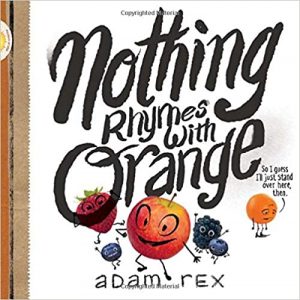Anti-Bullying
Nothing rhymes with orange

Author(s): Adam Rex
Links:
Amazon: https://amzn.to/2Y47YeS
Indigo: https://bit.ly/2WmjBMm
Social Justice focus: Pro-inclusion; diversity
Synopsis: This delightful parable sings the praises of various fruits through rhyme. The problem is that nothing rhymes with “orange” and the orange feels left out. In the end the other fruits create a word that rhymes with orange and everyone is happy.
Lesson Plan: Anthony Skrinjar
Primary/Junior/Intermediate Lesson Plan (Abbreviated Template)
Consecutive and Concurrent Programs
Unit/Topic: Social Justice & Picture Books
Grade: 4
Lesson: Social Justice: Nothing Rhymes with Orange
Curriculum Areas: Language Arts: Reading
Curriculum Expectations:
Overall:
Reading 1: read and demonstrate an understanding of a variety of literary, graphic, and informational texts, using a range of strategies to construct meaning
Writing 2: draft and revise their writing, using a variety of informational, literary, and graphic forms and stylistic elements appropriate for the purpose and audience
Oral Communication 1: listen in order to understand and respond appropriately in a variety of situations for a variety of purposes
Specific:
1.6 Extending Understanding: extend understanding of texts by connecting the ideas in them to their own knowledge, experience, and insights, to other familiar texts, and to the world around them
1.9 Point of View: identify the point of view presented in a text, citing supporting evidence from the text, and suggest some possible alternative perspectives
3.1 Reading Familiar Words: automatically read and understand high-frequency words, most regularly used words, and words of personal interest or significance in a variety of reading contexts
2.3 Word Choice: use specific words and phrases to create an intended impression
1.9 Presentation Strategies: identify the presentation strategies used in oral texts and analyze their effect on the audience
Learning Goal(s):
- We are learning to connect the meaning of picture books to real-life experiences
- We are learning to understand the point of view of a main character and supporting characters
- We are learning to relate different words that we know to each other in different reading styles
- We are learning to create a written piece using specific words and phrases related to a common theme.
Success Criteria:
- I can connect different types of readings to real-life experiences in the world around me
- I can understand and display the point of view of a specific character and supporting characters
- I can relate and connect familiar words to each other in different reading styles
- I can effectively write a story using specific words relating to a common theme while using different writing styles
MODIFICATIONS / ACCOMMODATIONS I can effectively meet the needs of my students firstly by grouping them into groups of 4-5 to complete the task given. With this task, students at a lower reading/writing level can be given easier and more familiar words.
Minds-on:
Minutes: 10 Minutes
Task:
- Begin by explaining that different forms of writing, especially picture books, always relay a clear message and different forms of writing are used;
- Have the students provide examples of different forms of writing and where they have seen them;
- After this, introduce the book Nothing Rhymes With Orange by Adam Rex and instruct the students to listen and view the illustrations carefully;
- Conduct a read aloud and question the students about what they think the meaning of the story is, and how is it relevant to everyday life.
Assessment: Assessment FOR Learning: Diagnostic Assessment. Anecdotal notes to record student participation in discussion.
Action:
Minutes: 30 Minutes
Task:
- Divide the class up into groups of 4-5 students each, ensuring to carefully select groups for differentiation/accommodation purposes detailed above;
- Provide each group with a set of 6 pictures (5 Characters & 1 Setting) and have them construct a story similar to Nothing Rhymes With Orange through connections via rhyming. [THE CATCH IS – ONE CHARACTER’S NAME DOESN’T RHYME WITH ANOTHER WORD (like orange)];
- Provide the class with 25 minutes to create their written piece;
Assessment: Assessment FOR Learning: Formative Assessment. Checklist along with Anecdotal Notes to monitor and evaluate student progress towards achieving the expectation.
Consolidation:
Minutes: 15
Task:
- When all pieces are complete, each group will present their creation to the other groups in the class – selected in random order for presentation;
- Once all presentations are complete, place each written piece on the wall in the classroom to show off their work!
- Review the connection between Nothing Rhymes With Orange & social justice and explain how each group met the expectation of connecting a piece to a real world experience.
Assessment: Assessment FOR Learning: Formative Assessment. Checklist along with Anecdotal Notes to monitor and evaluate student progress towards achieving the expectation.
MATERIALS: White Paper/Graph Paper; Sets of 6 pictures for every group; Markers; Nothing Rhymes With Orange by Adam Rex; PowerPoint Presentation
REFLECTION: Questions to determine the success of your lesson:
- Were my students successful in meeting the learning goals and success criteria? How do I know?
- Did my instructional decisions meet the needs of all students? If not, what are my next steps?
- What worked well and why?
- What will I do differently in the future when teaching this lesson? For the subsequent lesson?
- What are the next steps for my professional learning?

